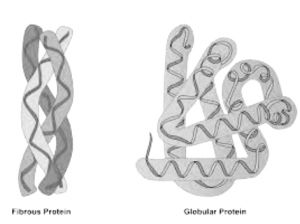Our bodies are brimming with protein. Amino acids combine to generate these molecules. To make a protein, these amino acids are linked together in a lengthy chain-like structure. Proteins are macromolecules (polymers) made up of smaller structural units. Protein is required for the majority of bodily processes. Proteins of many sorts aid in the proper functioning of our bodies. Proteins aid in the replication of DNA, the movement of molecules, the structural balance of cells and organs, the response to stimuli, and metabolic functions. Proteins are categorised according to their amino acid sequence, as well as their structure and function. Primary, secondary, tertiary, and quaternary structure are the four stages of protein structure.
Types of Proteins :
Protein can be found in our hair, nails, muscles, and haemoglobin in our red blood cells. Proteins are classified into three kinds based on their functions: globular, fibrous, and membrane proteins. These proteins aid in the body’s proper functioning. Let’s take a closer look at these three sorts of proteins.
- Globular Proteins : Spherical (“globe-like”) proteins, also known as globular proteins or spheroproteins, are one of the most frequent protein forms (the others being fibrous, disordered and membrane proteins). Globular proteins are water-soluble to a degree (forming colloids in water)
- Fibrous Proteins : Fibrous proteins, also known as scleroproteins, are one of the three major types of proteins (alongside globular and membrane proteins). Elongated or fibrous polypeptide chains generate filamentous and sheet-like structures in fibrous proteins.
- Membrane Proteins : Membrane proteins are proteins that are found in biological membranes or interact with them. Membrane proteins are classified into numerous types based on their location. Integral membrane proteins are a permanent part of a cell membrane that can either permeate it (transmembrane) or connect with one side or the other (integral monotopic). The cell membrane is transiently linked with peripheral membrane proteins.
Difference Between Fibrous and Globular Proteins :
Parameter | Globular Protein | Fibrous Protein |
Shape | Spherical in shape | Are long and narrow |
Purpose | Functional : This indicates that globular proteins in the body perform a specific biological purpose. | Structural : This suggests that these proteins act as a scaffolding to keep cells in form. |
Resilience | Temperature and pH are more sensitive. | Changes in temperature and pH have a lower impact on it. |
Acid Sequence | Irregular amino acid sequences | Repetitive amino acid sequences |
Examples | Haemoglobin, insulin, enzymes | Keratin, elastin, myosin |
Uses of these Proteins :
Globular Proteins :
- Haemoglobin : It is the pigment that gives our red blood cells their red colour. The red colour of our blood is due to haemoglobin. Its primary role is to store and deliver oxygen throughout the body. Decreased levels of haemoglobin can lead to lower levels of oxygen, whereas higher levels of haemoglobin can lead to thickening of the blood, which can lead to heart attacks and strokes.
- Insulin : It is a hormone produced by our pancreas that regulates the amount of sugar in our bodies. It permits glucose to enter our bodies and offer energy to our cells.
Fibrous Protein :
- Collagen : It is a protein that is found in abundance in humans (30 percent ). It is made up of amino acids, which are carbon, hydrogen, and oxygen molecules. It provides strength and protection to our numerous bodily components. It’s a crucial component of human skin and nails.
- Keratin : A fibrous protein found in human hair, nails, and skin, is a type of protein. It can also be found in the majority of our body’s organs.
Conclusion :
The major distinction between fibrous and globular proteins is that fibrous proteins are composed of long, narrow strands, whereas globular proteins are compact and spherical. In addition, fibrous proteins play a structural role in the body, whereas globular proteins play a functional purpose.In the body, there are two types of proteins: fibrous and globular. Both are critical to the body’s proper functioning.
 Profile
Profile Settings
Settings Refer your friends
Refer your friends Sign out
Sign out







